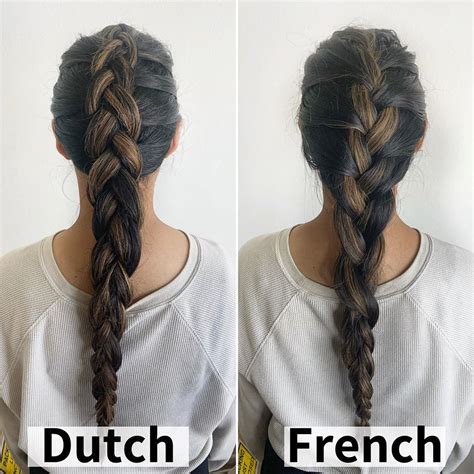Introduction
Braiding is an intricate art form that dates back centuries. Among the most popular braiding techniques are the French braid and the Dutch braid. While they share some similarities, these two braids have distinct characteristics and applications. This comprehensive guide delves into the intricate details of each technique, exploring their pros and cons, and providing valuable insights for hairstylists and fashion enthusiasts alike.

Section 1: Origins and History
French Braid:
- Developed in France during the 17th century
- Originally known as a “tresse à la française”
- Became popular among women of all social classes during the 19th century
Dutch Braid:
- Originated in the Dutch countryside during the 16th century
- Used as a practical way to secure long hair during manual labor
- Gained recognition as a fashionable hairstyle in the 20th century
Section 2: Techniques and Instructions
French Braid:
-
Technique:
- Section the hair into three strands
- Cross the right strand over the middle strand
- Cross the left strand over the new middle strand
- Repeat steps 2-3, gradually adding hair from the sides
- Continue braiding until all the hair is incorporated
-
Instructions:
- Brush hair to remove tangles
- Divide hair into three equal strands
- Hold the left strand between your thumb and index finger
- Cross the right strand over the middle strand
- Hold the right strand with your thumb and index finger
- Cross the left strand over the new middle strand
- Repeat steps 4-6, gradually adding hair from the sides
- Continue braiding until all the hair is incorporated
- Secure the end of the braid with a hair tie
Dutch Braid:
-
Technique:
- Invert the French braid technique
- Cross the right strand under the middle strand
- Cross the left strand under the new middle strand
- Repeat steps 2-3, gradually adding hair from the sides
- Continue braiding until all the hair is incorporated
-
Instructions:
- Brush hair thoroughly
- Divide hair into three equal sections
- Hold the left strand between your thumb and index finger
- Cross the right strand under the middle strand
- Hold the right strand with your thumb and index finger
- Cross the left strand under the new middle strand
- Repeat steps 4-6, gradually adding hair from the sides
- Continue braiding until all the hair is incorporated
- Tie off the end of the braid with a hair elastic
Section 3: Aesthetics and Applications
French Braid:
-
Aesthetics:
- Creates a smooth and elegant appearance
- Can be worn in various ways, including down, to the side, or even in a bun
- Suitable for all hair types and lengths
-
Applications:
- Everyday hairstyles
- Special occasions, such as weddings and proms
- Performance arts, such as ballet and ice skating
Dutch Braid:
-
Aesthetics:
- Produces a raised and voluminous effect
- Provides a more intricate and eye-catching look
- Ideal for thicker hair types
-
Applications:
- Braces a narrow forehead
- Highlights facial features
- Adds texture and interest to hair buns
Section 4: Pros and Cons
Pros:
-
French Braid:
- Versatile and stylish
- Suitable for all hair types
- Can be used for various occasions
-
Dutch Braid:
- Adds volume and interest
- Complements thicker hair types
- Highlights facial features
Cons:
-
French Braid:
- May be time-consuming to create
- Can cause tension on the hair if braided too tightly
-
Dutch Braid:
- May not be suitable for all hair lengths
- Can be more difficult to master than the French braid
Section 5: Comparison Table
| Feature | French Braid | Dutch Braid |
|---|---|---|
| Technique | Braid strands over each other | Braid strands under each other |
| Effect | Smooth and elegant | Raised and voluminous |
| Suitability | All hair types and lengths | Thicker hair types |
| Applications | Everyday hairstyles, special occasions, performance arts | Bracing a narrow forehead, highlighting facial features, adding texture to hair buns |
| Difficulty | Moderate | Challenging |
| Versatility | Can be worn in various ways | Limited styling options |
Section 6: Conclusion
The French braid and Dutch braid offer unique aesthetic and practical advantages that make them popular choices for hairstylists and fashion enthusiasts. Understanding the differences between these two techniques is crucial for creating the desired look. While the French braid reigns supreme in versatility and suitability, the Dutch braid steals the show with its volume and intricate appeal. Ultimately, the best choice depends on the individual’s hair type, desired outcome, and personal preferences.
